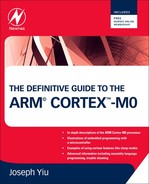0%
69Chapters
0-1Hours read
0kTotal Words
Book Description
The Definitive Guide to the ARM Cortex-M0 is a guide for users of ARM Cortex-M0 microcontrollers. It presents many examples to make it easy for novice embedded-software developers to use the full 32-bit ARM Cortex-M0 processor. It provides an overview of ARM and ARM processors and discusses the benefits of ARM Cortex-M0 over 8-bit or 16-bit devices in terms of energy efficiency, code density, and ease of use, as well as their features and applications.The book describes the architecture of the Cortex-M0 processor and the programmers model, as well as Cortex-M0 programming and instruction set and how these instructions are used to carry out various operations. Furthermore, it considers how the memory architecture of the Cortex-M0 processor affects software development; Nested Vectored Interrupt Controller (NVIC) and the features it supports, including flexible interrupt management, nested interrupt support, vectored exception entry, and interrupt masking; and Cortex-M0 features that target the embedded operating system. It also explains how to develop simple applications on the Cortex-M0, how to program the Cortex-M0 microcontrollers in assembly and mixed-assembly languages, and how the low-power features of the Cortex-M0 processor are used in programming. Finally, it describes a number of ARM Cortex-M0 products, such as microcontrollers, development boards, starter kits, and development suites.
This book will be useful to both new and advanced users of ARM Cortex devices, from students and hobbyists to researchers, professional embedded- software developers, electronic enthusiasts, and even semiconductor product designers.
- The first and definitive book on the new ARM Cortex-M0 architecture targeting the large 8-bit and 16-bit microcontroller market
- Explains the Cortex-M0 architecture and how to program it using practical examples
- Written by an engineer at ARM who was heavily involved in its development
Table of Contents
- Cover image
- Table of Contents
- Front Matter
- Copyright
- Foreword
- Preface
- Acknowledgments
- Conventions
- Terms and Abbreviations
- Chapter 1. Introduction
- Chapter 2. Cortex-M0 Technical Overview
- Chapter 3. Architecture
- Chapter 4. Introduction to Cortex-M0 Programming
- Chapter 5. Instruction Set
- Chapter 6. Instruction Usage Examples
- Chapter 7. Memory System
- Chapter 8. Exceptions and Interrupts
- Chapter 9. Interrupt Control and System Control
- Chapter 10. Operating System Support Features
- Chapter 11. Low-Power Features
- Chapter 12. Fault Handling
- Chapter 13. Debug Features
- Chapter 14. Getting Started with Keil MDK
- Chapter 15. Simple Application Programming
- Chapter 16. Assembly Projects and Mixed-Assembly and C Projects
- Chapter 17. Using Low-Power Features in Programming
- Chapter 18. Using SVC, PendSV, and Keil RTX Kernel
- Chapter 19. Getting Started with the ARM RealView Development Suite
- Chapter 20. Getting Started with the GNU C Compiler
- Chapter 21. Software Porting
- Chapter 22. Cortex-M0 Products
- Appendix A. Instruction Set Summary
- Appendix B. Cortex-M0 Exception Type Quick Reference
- Appendix C. CMSIS Quick Reference
- Appendix D. NVIC, SCB, and SysTick Registers Quick Reference
- Appendix E. Debug Registers Quick Reference
- Appendix F. Debug Connector Arrangement
- Appendix G. Linker Script for CodeSourcery G++ Lite
- Appendix H. Example Code Files
- Appendix I. Troubleshooting
- Index
